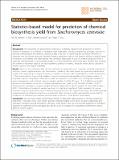Statistics-based model for prediction of chemical biosynthesis yield from Saccharomyces cerevisiae
Author(s)
Xiao, Yi; Leonard, Effendi; Varman, Arul M.; Tang, Yinjie J.
Download1475-2859-10-45.pdf (463.0Kb)
PUBLISHER_CC
Publisher with Creative Commons License
Creative Commons Attribution
Terms of use
Metadata
Show full item recordAbstract
Background: The robustness of Saccharomyces cerevisiae in facilitating industrial-scale production of ethanol extends its utilization as a platform to synthesize other metabolites. Metabolic engineering strategies, typically via pathway overexpression and deletion, continue to play a key role for optimizing the conversion efficiency of substrates into the desired products. However, chemical production titer or yield remains difficult to predict based on reaction stoichiometry and mass balance. We sampled a large space of data of chemical production from S. cerevisiae, and developed a statistics-based model to calculate production yield using input variables that represent the number of enzymatic steps in the key biosynthetic pathway of interest, metabolic modifications, cultivation modes, nutrition and oxygen availability. Results: Based on the production data of about 40 chemicals produced from S. cerevisiae, metabolic engineering methods, nutrient supplementation, and fermentation conditions described therein, we generated mathematical models with numerical and categorical variables to predict production yield. Statistically, the models showed that: 1. Chemical production from central metabolic precursors decreased exponentially with increasing number of enzymatic steps for biosynthesis (>30% loss of yield per enzymatic step, P-value = 0); 2. Categorical variables of gene overexpression and knockout improved product yield by 2~4 folds (P-value < 0.1); 3. Addition of notable amount of intermediate precursors or nutrients improved product yield by over five folds (P-value < 0.05); 4. Performing the cultivation in a well-controlled bioreactor enhanced the yield of product by three folds (P-value < 0.05); 5. Contribution of oxygen to product yield was not statistically significant. Yield calculations for various chemicals using the linear model were in fairly good agreement with the experimental values. The model generally underestimated the ethanol production as compared to other chemicals, which supported the notion that the metabolism of Saccharomyces cerevisiae has historically evolved for robust alcohol fermentation. Conclusions: We generated simple mathematical models for first-order approximation of chemical production yield from S. cerevisiae. These linear models provide empirical insights to the effects of strain engineering and cultivation conditions toward biosynthetic efficiency. These models may not only provide guidelines for metabolic engineers to synthesize desired products, but also be useful to compare the biosynthesis performance among different research papers.
Date issued
2011-06Department
Massachusetts Institute of Technology. Department of Chemical EngineeringJournal
Microbial Cell Factories
Publisher
BioMed Central Ltd
Citation
Microbial Cell Factories. 2011 Jun 21;10(1):45
Version: Final published version
ISSN
1475-2859